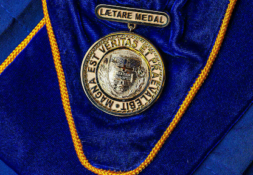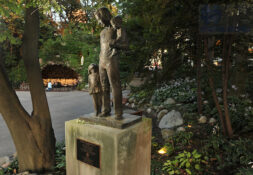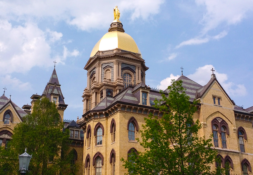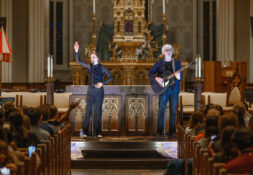Since 1964, the Word of Life stone mural decorating the entrance of the Hesburgh Library has been an architectural icon on campus. The famous mural, also known as “Touchdown Jesus,” was generously paid for by Howard V. Phalin at a cost of $200,000. Millard Sheets, an architect, stonemason, and sculptor, was commissioned to create the mural.
Fr. Hesburgh told the story of the library’s development. “When I became president, it was ridiculous that we only had 25,000 volumes so they asked me, ‘Do you want to double the library?’ And I said no. They asked me, ‘Do you want to build the library for a million volumes?’ And I said no. So, they asked me what I wanted, and I said 6 million volumes. They told me, ‘You’re out of your tree,’ but I said, ‘Let me tell you something. We will have over 6 million volumes in the library, and we will be looking for outside storage. That’s what made this a great university: a great library, and a Catholic library. When we built this building and looked at it, it didn’t have much character, so I asked Millard Sheets, an artist in California, ‘What can you do to dress up the front of our library?’”
Sheets decided to depict Christ the Teacher surrounded by the saints, scholastics, the Romans, the Greeks, and other great thinkers. Fr. Hesburgh credits Sheets with the design, but he did make sure Sheets included the Apostles, St. Thomas Aquinas, and other important Christian thinkers in the mural.
In a 1964 interview with Notre Dame’s SCHOLASTIC magazine, Sheets said, “What they asked me to do was to suggest in a great processional the idea of a never-ending line of great scholars, thinkers, and teachers – saints that represented the best that man has recorded, and which are found represented in a library. The thought was that the various periods that are suggested in the theme have unfolded in the continuous process of one generation giving to the next. I put Christ at the top with the disciples to suggest that He is the great teacher – that is really the thematic idea.”
The mural’s title comes from the opening passage in the Gospel of John: “In the beginning was the Word: the Word was with God and the Word was God. He was with God in the beginning. Through him all things came to be, not one thing had its being but through him. All that came to be had life in him. And that life was the light of men, a light that shines in the dark, a light that darkness could not overpower.”
Fr. Hesburgh also commented on the design process. “Just to draw out the face of Christ took a sheet of paper almost the size of my office. The face of Christ is most important part of the mural – it’s spectacular, and Sheets used 90 shades of granite, 3 different approaches: raw, polished, and a little bit polished.”
Hesburgh Library’s website quotes University of Notre Dame Professor of Geology Erhard M. Winkler in a 1967 article in STONE magazine: “In all, 81 different stones, in 171 finishes, and from 16 countries, were used in fabrication. … The following kinds of stone were utilized: 46 granites and syenites; 10 gabros and labradorites; 4 metamorphic gneisses; 12 serpentines; 4 crystalline marbles; and 5 limestones.”
Because Christ’s hands are raised in the mural, he has been given the nickname, “Touchdown Jesus.” Marsha Stevenson, a librarian in the Notre Dame Art, Architecture and Media Department, suspects that the position of Christ’s hands may not have been entirely coincidental. She said, “One thing I can tell you from my many hours of patient research in the Archives is that no place could I find any documentation confirming that the arms-raised gesture was a deliberate ‘touchdown’ reference by Millard Sheets. However, the more natural gesture would have been for Christ to have his arms down. If Sheets didn’t do this deliberately, maybe he did it subconsciously?”
Returning to the mural’s original meaning, Fr. Hesburgh says of its infamous nickname, “Everything gets a motto around here—my title is ‘Christ Amidst Saints and Scholars.’ As far as I’m concerned they can throw out the nickname tomorrow.”
Stephanie House is a junior PLS major who resides in Welsh Family Hall. She can play the ukulele. Contact her at shouse1@nd.edu.





